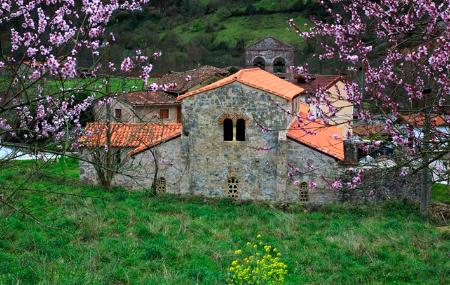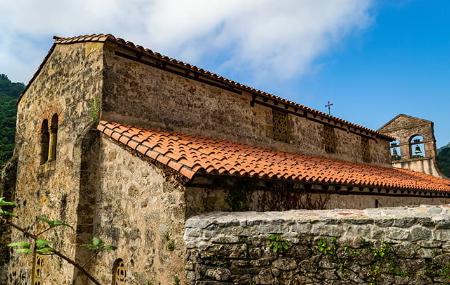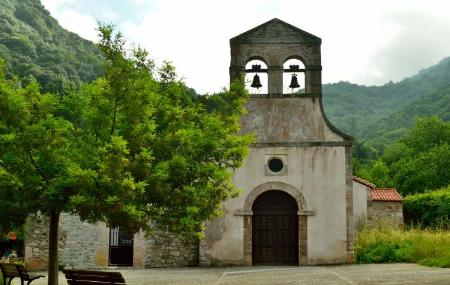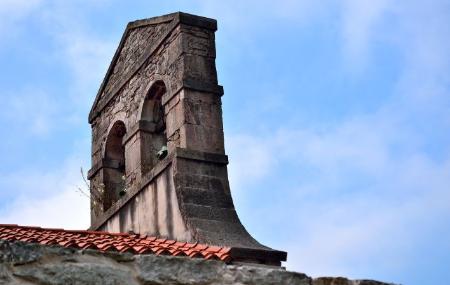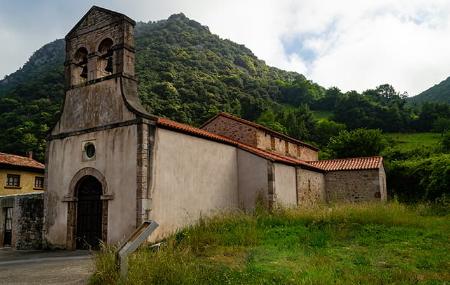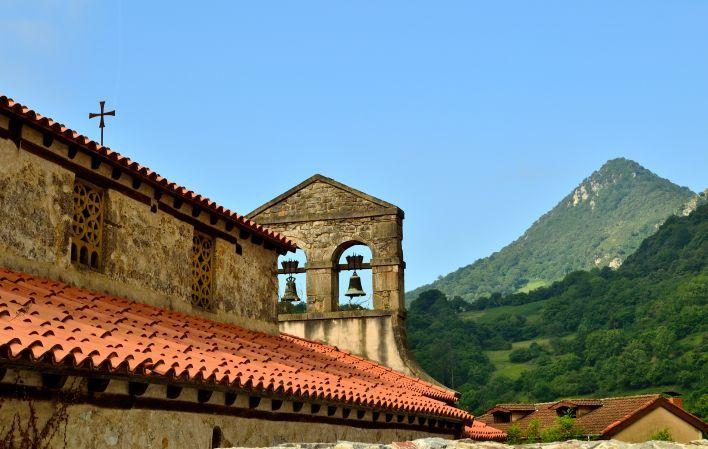
Church of Santo Adriano de Tuñón
- Location Santo Adriano Asturias Centre
- Address Address: ■ 33115 - Tuñón
- Phone Phone: 691 504 045 (imprescindible reserva previa) | 985 761 403
- Email Email: info@laponte.org
- Site: Visit
- Schedules and prices: View
In the heart of the idyllic Trubia valley, in the town of Tuñón (municipality of Santo Adriano), we find one of the most emblematic churches in Asturias. Declared a National Monument in 1931, it formed part of a Benedictine abbey in the 9th century and was endowed with land and an entire village at its disposal to support the monks, provide aid to the poor and offer lodging to pilgrims.
Most of the monastic complex disappeared over the centuries and only the church remains standing. Inside the church we find its mural paintings, considered to be the oldest Mozarabic paintings documented on the peninsula. This is one of the least known jewels of pre-Romanesque art in Asturias.
History of the Church of Santo Adriano
Founded under the reign of Alfonso III and Queen Jimena, its history is the chronicle of resistance. Its millenary walls and its religious power had to overcome the sway of the ages and the continuous reforms.
Origins and historical context
It was consecrated in 891 in honour of the martyrs Saint Hadrian, a former Roman officer, and his wife, Natalia. Their relics were taken from Rome to León, thus strengthening the connection between the kingdom of Asturias and the Holy See. But the foundation of this temple was not merely a devotional act. Tuñón was also erected as a symbol of victory and a tribute to the last deed of Pelayo. Some historians place it very close to the scene of the battle of Olalies (724), in which Pelayo, after having won at Cuadonga/Covadonga, definitively defeated the Muslims who were retreating towards the plateau. The battle may have taken place in the nearby valley of Valdolayés, a beautiful spot at the foot of the Desfiladero de las Xanas gorge - through which one of the most popular hiking routes in Asturias now runs.
Both as a symbol of royal and religious power, the historical importance of Santo Adriano is beyond doubt. Five bishops took part in its consecration and it became part of a network of monasteries dependent on the monarchy. An economic and social model inspired by the Roman "villae", with nuclei of agricultural production supporting the lay and ecclesiastical aristocracy, a kind of early feudal system.
In addition to all this, the site of Tuñón was strategically located on the route that has linked Asturias with Castile since ancient times: the Camín Real de la Mesa, which guaranteed its security and access to the resources needed to sustain the abbey. On the other hand, studies support its connection with the first Jacobean routes and the Primitive Way to Santiago - in fact, one of its many dedications was dedicated to the apostle Saint James.
Restoration and conservation
The temple faced ruin and oblivion between the 10th and 11th centuries, losing its autonomy to the diocese of Oviedo in 1096. The reform of 1108, promoted by Bishop Pelayo, meant its definitive transformation into a parish church. During the 17th and 18th centuries, the front and the top of the belfry were added, as well as a new nave body that replaced an old tripartite portico. All this altered its profile and marked a stylistic transition towards more modern forms.
In the mid-20th century, the church came under the restoring eye of Luis Menéndez Pidal, who, apart from other actions, brought to light the splendid Mozarabic-influenced paintings hidden in the main chapel. In the 1980s, a new project led by specialists in Asturian religious architecture eliminated modern additions and emphasised its pre-Romanesque structures. In 2008 the façades and roof were strengthened. In 2016 the paintings were restored and isolated from humidity with a new drainage system on the exterior walls.
Architectural highlights
In recent decades, archaeological surveys, wall studies and other research have complemented our understanding of the building.
Original pre-Romanesque elements
The Church of Santo Adriano de Tuñón is a paradigmatic example of pre-Romanesque architecture, characterised by its formal simplicity and spiritual symbolism. The basilica plan, with three naves separated by semicircular arches, reflects the influence of architectural models typical of the period. Above the main chapel, as in other pre-Romanesque constructions, we find the secret chamber, although in this case, in addition to opening only to the outside through a mullioned window, the chamber also opens to the inside (probably due to a later alteration).
The church is illuminated by a window in each apse and three on each side of the central nave, all with decorated latticework. The masterly balance between light and shadow guides the eye upwards and the overall sobriety speaks for itself, as if the space had chosen to strip away the superfluous in order to highlight the essential.
Decoration and symbolic details
The pre-Romanesque decoration of this church demonstrates that simplicity can be sublime, as is the case with the remains of the mural paintings in the main chapel. Of particular note are the allegories of the sun and the moon, which represent the duality of the cosmos and the notion of transcendence, the idea of a universal order governed by divine principles. Below them is a frieze with Muslim-style scalloped battlements, and above them a delicate display of flowers and bouquets from which sprouts a cross reminiscent of the Victoria Cross. The persistence of Mozarabic elements in this mural reinforces the theory - not at all common - that craftsmen from al-Andalus would have worked on this Asturian temple.
The central apse rests on stone corbels decorated with palm-leaf engravings and interlaced motifs representing spiritual victory and eternity. A piece of a grey marble doorway decorated with vegetal motifs has also survived.
Recommendations for visitors
There are programmed visits through the Ecomuseum La Ponte, based in the capital of the council, Villanueva. The guided tours, which last approximately one hour, require prior booking, by email : info@laponte.org or by telephone: 691 504 045.
We suggest arriving early to enjoy the tranquillity of the place and take advantage of the morning light, which enhances the architectural details and the natural beauty of the surroundings. It is also advisable to wear comfortable shoes, as the surroundings of the church invite you to explore the rural paths. There is a small step inside the church which may be difficult for wheelchair users.
Who should not miss this visit?
Lovers of cultural tourism and history, those in search of natural sites of great beauty or those who have organised a trip to the very popular Senda del Oso (Bear Trail), very close to the church.
Schedules and prices
- 30 October to 30 May
Saturdays: 11:00
Sundays: 11:00 and 18:00
- Free
How to get here
First Name: Church of Santo Adriano de Tuñón
GPS: 43.291615,-5.981285
Address: ■ 33115 - Tuñón

